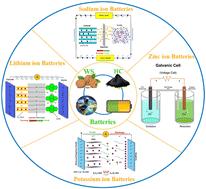Our official English website, www.x-mol.net, welcomes your
feedback! (Note: you will need to create a separate account there.)
What is the potential of walnut shell-derived carbon in battery applications?
Nanoscale ( IF 5.8 ) Pub Date : 2024-11-20 , DOI: 10.1039/d4nr03460k Lamiae Oulbaz, Meriem Kasbaji, Mustapha Oubenali, Amine Moubarik, Zineb Kassab, Abdelwahed Chari, Mouad Dahbi, Mounir El Achaby
Nanoscale ( IF 5.8 ) Pub Date : 2024-11-20 , DOI: 10.1039/d4nr03460k Lamiae Oulbaz, Meriem Kasbaji, Mustapha Oubenali, Amine Moubarik, Zineb Kassab, Abdelwahed Chari, Mouad Dahbi, Mounir El Achaby

|
The environmental implications of utilizing walnut shells (WSs) as a material for energy storage are complex, balanced between advancing technologies and improving efficiency. This review aims to address, for the first time, environmental concerns and health effects associated with this material by conducting an in-depth analysis of carbon materials derived from waste management systems. Beginning with a reevaluation of the structural characteristics, cellular morphology, and physicochemical properties of WSs, this study explores their potential for the efficient synthesis of carbon. By examining various methods for the production of WS-derived materials such as hard carbon, we demonstrate the multifaceted nature of WS biomass as a resource. Subsequently, we shift our focus to ion storage mechanisms in the carbon source (C–S), including storage sensitivity, ion intercalation in micropores, and layer intercalation. An electrochemical analysis of the carbon source reveals its potential applications in energy storage systems. Furthermore, life cycle analysis was employed to assess the environmental impact and economic viability of WS utilization. The findings of the analysis suggest that one of the most valuable attributes of WSs is their potential for creating more environmentally sustainable materials, encouraging researchers to promote the use of green components in sodium batteries. This review underscores, for the first time, the significance of WSs in the field of carbon energy storage and their potential to enhance future prospects. The substantial opportunities in this area warrant further research and development, highlighting the relevance of WS-derived materials in advancing sustainable energy storage solutions.
中文翻译:

核桃壳衍生碳在电池应用中的潜力是什么?
利用核桃壳 (WS) 作为储能材料对环境的影响是复杂的,需要在先进技术和提高效率之间取得平衡。本综述旨在通过对来自废物管理系统的碳材料进行深入分析,首次解决与这种材料相关的环境问题和健康影响。本研究从重新评估 WSs 的结构特征、细胞形态和物理化学性质开始,探讨了它们高效合成碳的潜力。通过研究生产 WS 衍生材料(如硬碳)的各种方法,我们证明了 WS 生物质作为一种资源的多面性。随后,我们将重点转移到碳源 (C-S) 中的离子存储机制,包括存储灵敏度、微孔中的离子嵌入和层嵌入。碳源的电化学分析揭示了其在储能系统中的潜在应用。此外,采用生命周期分析来评估 WS 利用的环境影响和经济可行性。分析结果表明,WS 最有价值的属性之一是它们具有创造更环保可持续材料的潜力,鼓励研究人员在钠电池中推广使用绿色成分。本综述首次强调了 WS 在碳储能领域的重要性及其增强未来前景的潜力。该领域的巨大机会值得进一步研究和开发,凸显了 WS 衍生材料在推进可持续储能解决方案方面的相关性。
更新日期:2024-11-20
中文翻译:

核桃壳衍生碳在电池应用中的潜力是什么?
利用核桃壳 (WS) 作为储能材料对环境的影响是复杂的,需要在先进技术和提高效率之间取得平衡。本综述旨在通过对来自废物管理系统的碳材料进行深入分析,首次解决与这种材料相关的环境问题和健康影响。本研究从重新评估 WSs 的结构特征、细胞形态和物理化学性质开始,探讨了它们高效合成碳的潜力。通过研究生产 WS 衍生材料(如硬碳)的各种方法,我们证明了 WS 生物质作为一种资源的多面性。随后,我们将重点转移到碳源 (C-S) 中的离子存储机制,包括存储灵敏度、微孔中的离子嵌入和层嵌入。碳源的电化学分析揭示了其在储能系统中的潜在应用。此外,采用生命周期分析来评估 WS 利用的环境影响和经济可行性。分析结果表明,WS 最有价值的属性之一是它们具有创造更环保可持续材料的潜力,鼓励研究人员在钠电池中推广使用绿色成分。本综述首次强调了 WS 在碳储能领域的重要性及其增强未来前景的潜力。该领域的巨大机会值得进一步研究和开发,凸显了 WS 衍生材料在推进可持续储能解决方案方面的相关性。


















































 京公网安备 11010802027423号
京公网安备 11010802027423号